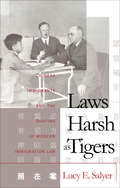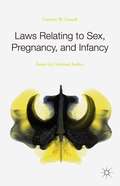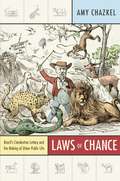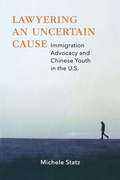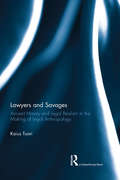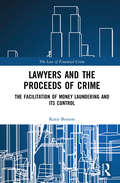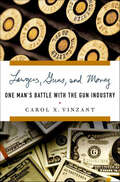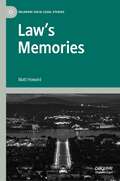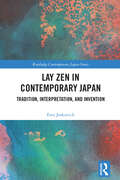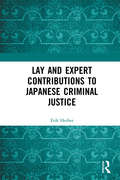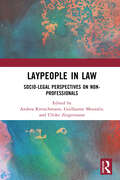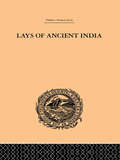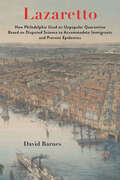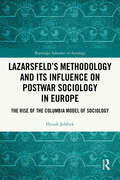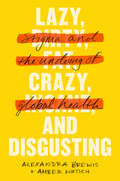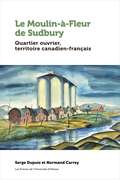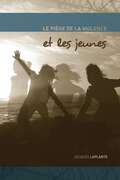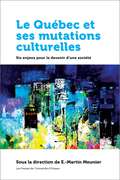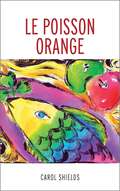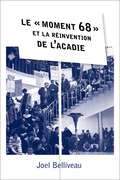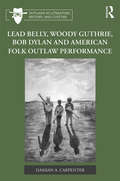- Table View
- List View
Laws Harsh As Tigers
by Lucy E. SalyerFocusing primarily on the exclusion of the Chinese, Lucy Salyer analyzes the popular and legal debates surrounding immigration law and its enforcement during the height of nativist sentiment in the early twentieth century. She argues that the struggles between Chinese immigrants, U.S. government officials, and the lower federal courts that took place around the turn of the century established fundamental principles that continue to dominate immigration law today and make it unique among branches of American law. By establishing the centrality of the Chinese to immigration policy, Salyer also integrates the history of Asian immigrants on the West Coast with that of European immigrants in the East.Salyer demonstrates that Chinese immigrants and Chinese Americans mounted sophisticated and often-successful legal challenges to the enforcement of exclusionary immigration policies. Ironically, their persistent litigation contributed to the development of legal doctrines that gave the Bureau of Immigration increasing power to counteract resistance. Indeed, by 1924, immigration law had begun to diverge from constitutional norms, and the Bureau of Immigration had emerged as an exceptionally powerful organization, free from many of the constraints imposed upon other government agencies.
Laws Relating to Sex, Pregnancy, and Infancy
by Carmen M. CusackLaws Relating to Sex, Pregnancy, and Infancy examines case law and legislation in regards to reproduction, pregnancy, and infancy. Cusack explores the winding pathways of legal precedence and action on the social conditions of pregnancy and childbirth, and draws from criminal and court procedures and behavioral science to determine if the law is acting in the best interest of those vulnerable populations. Cusack surveys interpersonal, familial, and societal problems presented throughout history and currently facing contemporary generations, questioning whether the criminal justice system can evolve to support the growing needs of its citizens most in need of legal assistance.
Laws of Chance: Brazil's Clandestine Lottery and the Making of Urban Public Life
by Amy ChazkelThe lottery called the jogo do bicho, or "animal game," originated as a raffle at a zoo in Rio de Janeiro in 1892. During the next decade, it became a cultural phenomenon all over Brazil, where it remains popular today. Laws of Chance chronicles the game's early history, as booking agents, dealers, and players spread throughout Rio and the lottery was outlawed and driven underground. Analyzing the game's popularity, its persistence despite bouts of state repression, and its sociocultural meanings, Amy Chazkel unearths a rich history of popular participation in urban public life in the decades after the abolition of slavery in 1888 and the establishment of the Brazilian republic in 1889. Contending that the jogo do bicho was a precursor to the massive informal economies that developed later in the twentieth century, she sheds new light on the roots of the informal trade that is central to daily life in urban Latin America. The jogo do bicho operated as a form of unlicensed petty commerce in the vast gray area between the legal and the illegal. Police records show that players and ticket sellers were often arrested but rarely prosecuted. Chazkel argues that the animal game developed in dialogue with the official judicial system. Ticket sellers, corrupt police, and lenient judges worked out a system of everyday justice that would characterize public life in Brazil throughout the twentieth century.
Laws of Transgression: The Return of Judge Schreber
by Peter Goodrich Katrin TrüstedtLaws of Transgression offers multiple perspectives on the story of Daniel Paul Schreber (1842–1911), a chamber president of the German Supreme Court who was institutionalized after claiming God had communicated with him, desiring to make him into a woman. Schreber was not only a successful judge, but was also to become the author of one of the most commented upon texts in psychiatric literature, Memoirs of My Nervous Illness. Published in 1903, this remarkable work documented Schreber’s visions, desires, jurisprudence, and theology. Far from ending the judge’s legal investments, it manifested an intensification of engagement with the law in the attempt to prove that becoming a woman did not deprive the judge of legal competence. Schreber’s experience of bodily change and his account of interior life has been the subject of more than a century of psychoanalytic and medical scrutiny. With the contemporary trans turn, interest in the judge’s desire to become a woman has intensified. In Laws of Transgression, Peter Goodrich, Katrin Trüstedt, and contributing authors set out to unfold Schreber’s complex relation to the law. The collection revisits and rediscovers the Memoirs, not only in its juridical and political implications, but as a transgressional text that has challenged law and heteronormativity.
Lawyering an Uncertain Cause: Immigration Advocacy and Chinese Youth in the US
by Michele StatzEach year, a number of youth who migrate alone and clandestinely from China to the United States are apprehended, placed in removal proceedings, and designated as unaccompanied minors. These young migrants represent only a fraction of all unaccompanied minors in the US, yet they are in many ways depicted as a preeminent professional and moral cause by immigration advocates.In and beyond the legal realm, the figure of the "vulnerable Chinese child" powerfully legitimates legal claims and attorneys' efforts. At the same time, the transnational ambitions and obligations of Chinese youth implicitly unsettle this figure. Youths' maneuvers not only belie attorneys' reliance on racialized discourses of childhood and the Chinese family, but they also reveal more broad uncertainties around legal frameworks, institutional practices, health and labor rights—and cause lawyering itself.Based on three years of fieldwork across the United States, Lawyering an Uncertain Cause is a novel study of the complex and often contradictory rights, responsibilities, and expectations that motivate global youth and the American attorneys who work on their behalf.
Lawyers and Savages: Ancient History and Legal Realism in the Making of Legal Anthropology
by Kaius TuoriLegal primitivism was a complex phenomenon that combined the study of early European legal traditions with studies of the legal customs of indigenous peoples. Lawyers and Savages: Ancient History and Legal Realism in the Making of Legal Anthropology explores the rise and fall of legal primitivism, and its connection to the colonial encounter. Through examples such as blood feuds, communalism, ordeals, ritual formalism and polygamy, this book traces the intellectual revolution of legal anthropology and demonstrates how this scholarship had a clear impact in legitimating the colonial experience. Detailing how legal realism drew on anthropology in order to help counter the hypothetical constructs of legal formalism, this book also shows how, despite their explicit rejection, the central themes of primitive law continue to influence current ideas – about indigenous legal systems, but also of the place and role of law in development. Written in an engaging style and rich in examples from history and literature, this book will be invaluable to those with interests in legal realism, legal history or legal anthropology.
Lawyers and the Proceeds of Crime: The Facilitation of Money Laundering and its Control (The Law of Financial Crime)
by Katie BensonThe role played by legal professionals in the laundering of criminal proceeds generated by others has become a priority concern for authorities at national and international levels. This ground-breaking book presents an in-depth empirical analysis of the nature of lawyers’ involvement in the facilitation of money laundering and its control through criminal justice and regulatory mechanisms. It is based on qualitative research combining analysis of cases of lawyers convicted of money laundering offences with interviews with criminal justice practitioners, members of professional and regulatory bodies and practising solicitors, and analysis of relevant national and international legislative and regulatory frameworks. The book demonstrates the complex and diverse nature of lawyers’ involvement in laundering activity, and shows that their actions and the decisions they take must be understood in relation to the specific situational contexts in which they occur. It provides significant new insights into the criminal justice and regulatory response to professional facilitation of money laundering in the UK, raising questions about the effectiveness and appropriateness of the response and the challenges involved. The book develops a framework for future research and analysis in this area, and proposes a range of potential strategies for controlling the facilitation of money laundering. Lawyers and the Proceeds of Crime is essential reading for those researching money laundering, white-collar crime or organised crime, and for practitioners and policy makers concerned with preventing the facilitation of money laundering.
Lawyers, Guns, and Money: One Man's Battle with the Gun Industry
by Carol X. VinzantThis inspiring book, Lawyers, Guns, and Money by Carol X. Vinzant, recounts the heroic efforts of Tom McDermott, a lawyer and victim of the infamous Colin Ferguson rampage on the Long Island Railroad, to take on the gun industry. He is among the leaders of an innovative and promising strategy to circumvent the NRA's political power and courts constrained by interpretations of the Second Amendment. Through civil action he hits the gun companies where it hurts most: the bottom line. Making insurance difficult for manufacturers to get, he has helped reduce the number of cheap hand guns, "Saturday Night Specials," often used in crime. This is a riveting account of tragedy turned into action, and how the law can be used to defend victims rather than enrich corporations.
Law’s Memories (Palgrave Socio-Legal Studies)
by Matt HowardThis book discusses the relationship between law and memory and explores the ways in which memory can be thought of as contributing to legal socialization and legal meaning-making. Against a backdrop of critical legal pluralism which examines the distributedness of law(s), this book introduces the notion of mnemonic legality. It emphasises memory as a resource of law rather than an object of law, on the basis of how it substantiates senses of belonging and comes to frame inclusions and exclusions from a national community on the basis of linear-trajectory and growth narratives of nationhood. Overall, it explores the sensorial and affective foundations of law, implicating memory and perceptions of belonging within this process of creating legality and legitimacy. By identifying how memory comes to shape and inform notions of law, it contributes to legal consciousness research and to important questions informing much socio-legal research.
Lay Zen in Contemporary Japan: Tradition, Interpretation, and Invention (Routledge Contemporary Japan Series)
by Erez JoskovichThis book explores the emergence and growth of Zen as a non-monastic spiritual practice in modern Japan. Focusing on several prominent lay Zen associations, most notably Ningen Zen, it explores different aspects of lay Zen as a lived religion, such as organization, ideology, and ritual. Through a combined approach utilizing Buddhist text, historical sources, and ethnographic fieldwork, it explains how laypeople have appropriated religious authority and tailored Zen teachings to fit their needs and the zeitgeist.Featuring the findings of three years of fieldwork, interviews, and archival research, the book comprehensively describes various Zen practices and explores their contemporary meaning and functions. It undermines the distinction between traditional or established Buddhism and the so-called New Religions, emphasizing instead the dynamic relations between tradition and interpretation.Written in accessible language and offering insightful analysis, this book brings to light the essential role of lay Zen associations in modernizing Zen within Japan and beyond. It will be of interest to scholars and students of religious studies, particularly those studying Buddhism, Japanese society, and culture.
Lay and Expert Contributions to Japanese Criminal Justice: Legal Outsiders
by Erik HerberThis book examines the little or not previously researched roles and contributions of non-legal professionals in Japanese criminal justice against the background of recent social and legal changes that either gave birth to or affected the roles played by these "outsiders". On the basis of a wealth of primary and secondary sources, including meeting records of policy makers and practitioners, surveys, interviews and court verdicts, the book zooms in on forensic psychiatrists’ role in the disappearance of criminally insane defendants from Japanese criminal courts; social workers’ new role in diverting a growing number of elderly, mentally disturbed repeat offenders from prison; the therapeutic dimension added to Japanese criminal justice proceedings with the introduction of a system of victim participation as well as the increasingly important role of forensic scientists’ contributions, notably DNA evidence, in Japanese courts. Finally, it examines lay judges’ contributions to sentencing practices as well as how these lay judges make sense of the other outsiders’ contributions. On the basis of very recent social and legal developments the book provides an original contribution to understandings of Japanese criminal justice, as well as more general socio-legal debates on the role of extra-legal knowledge in criminal justice. The book will be of value within BA and MA level courses on and to students and researchers of Japanese law and society as well as comparative criminal justice and socio-legal theory.
Laypeople in Law: Socio-Legal Perspectives on Non-Professionals
by Guillaume Mouralis Ulrike Zeigermann Andrea KretschmannThis book contributes to a better understanding of the role laypeople hold in the social functioning of law.It adopts the scholarly insight that the law is unthinkable without an everyday legal understanding of the law pursued by laypeople. It engages with the assumption that not only the law’s existence but also its development is shaped by the layperson’s affirmations, oppositions, ignorance, or negations of the law. This volume thus aims to fill a void in socio-legal studies. Whereas many sociolegal theories tend to conceptualize the law through legal experts’ actions, institutions, procedures, and codifications, it argues that such a viewpoint underestimates the role of laypeople in the law’s processing and advocates for a strengthened conceptual place in socio-legal theory.This book will appeal to socio-legal scholars and sociologists (of law), as well as to legal practitioners and laypersons themselves.
Lays of Ancient India: Selections from Indian Poetry Rendered into English Verse (Trubner's Oriental Ser.)
by Romesh Chunder DuttFirst published in 2000. Routledge is an imprint of Taylor & Francis, an informa company.
Lazaretto: How Philadelphia Used an Unpopular Quarantine Based on Disputed Science to Accommodate Immigrants and Prevent Epidemics
by David S. BarnesHow the controversial practice of quarantine saved nineteenth-century Philadelphia after a series of deadly epidemics.In the 1790s, four devastating yellow fever epidemics threatened the survival of Philadelphia, the nation's capital and largest city. In response, the city built a new quarantine station called the Lazaretto downriver from its port. From 1801 to 1895, a strict quarantine was enforced there to protect the city against yellow fever, cholera, typhus, and other diseases. At the time, the science behind quarantine was hotly contested, and the Board of Health in Philadelphia was plagued by internal conflicts and political resistance. In Lazaretto, David Barnes tells the story of how a blend of pragmatism, improvisation, and humane care succeeded in treating seemingly incurable diseases and preventing further outbreaks.Barnes shares the lessons of the Lazaretto through a series of tragic and inspiring true stories of people caught up in the painful ordeal of quarantine. They include a nine-year-old girl enslaved in West Africa and freed upon arrival in Philadelphia, an eleven-year-old orphan boy who survived yellow fever only to be scapegoated for starting an epidemic, and a grieving widow who saved the Lazaretto in the midst of catastrophe. Spanning a turbulent century of immigration, urban growth, and social transformation, Lazaretto takes readers inside the life-and-death debates and ordinary heroism that saved Philadelphia when its survival as a city was at stake. Amid the controversy and tragedy of the COVID-19 pandemic, this surprising reappraisal of America's historic struggle against deadly epidemics reminds us not to neglect old knowledge and skills in our rush to embrace the new.
Lazarsfeld’s Methodology and Its Influence on Postwar Sociology in Europe: The Rise of the Columbia Model of Sociology (Routledge Advances in Sociology)
by Hynek JeřábekThis book explains how the Columbia model of sociology, which was based on the methodology of P.F. Lazarsfeld, became a dominant sociological school of thought in American and European postwar sociology.Providing an overview of Lazarsfeld’s inventions and his methodological, organisational, and institutional innovations, it describes the means by which a particular model of sociology was gradually adopted in departments headed by Lazarsfeld and in the work of his successors. With attention to the use by Lazarsfeld of methodological texts published by prestigious publishing houses in his research and teaching, his activity in international organisations – including the UN – his collaboration with figures such as Robert K. Merton and Raymond Boudon, and his attempts to show how the roots of his empirical research methodology lay in the work of early European scholars, this volume shows how a particular sociological paradigm came to prevail over others for more than a decade.It will therefore appeal to scholars of sociology with interests in the history of the discipline and questions of research methodology.
Lazy, Crazy, and Disgusting: Stigma and the Undoing of Global Health
by Alexandra Brewis Amber WutichPromotional headline: How stigma derails well-intentioned public health efforts, creating suffering and worsening inequalities.2020 Winner, Society for Anthropological Sciences Carol R. Ember Book PrizeShortlisted for the British Sociological Association's Foundation for the Sociology of Health and Illness Book PrizeStigma is a dehumanizing process, where shaming and blaming are embedded in our beliefs about who does and does not have value within society. In Lazy, Crazy, and Disgusting, medical anthropologists Alexandra Brewis and Amber Wutich explore a darker side of public health: that well-intentioned public health campaigns can create new and damaging stigma, even when they are otherwise successful. Brewis and Wutich present a novel, synthetic argument about how stigmas act as a massive driver of global disease and suffering, killing or sickening billions every year. They focus on three of the most complex, difficult-to-fix global health efforts: bringing sanitation to all, treating mental illness, and preventing obesity. They explain how and why humans so readily stigmatize, how this derails ongoing public health efforts, and why this process invariably hurts people who are already at risk. They also explore how new stigmas enter global health so easily and consider why destigmatization is so very difficult. Finally, the book offers potential solutions that may be able to prevent, challenge, and fix stigma. Stigma elimination, Brewis and Wutich conclude, must be recognized as a necessary and core component of all global health efforts.Drawing on the authors' keen observations and decades of fieldwork, Lazy, Crazy, and Disgusting combines a wide array of ethnographic evidence from around the globe to demonstrate conclusively how stigma undermines global health's basic goals to create both health and justice.
Le Maya Q'atzij/Our Maya Word: Poetics of Resistance in Guatemala (Indigenous Americas)
by Emil’ KemeBringing to the fore the voices of Maya authors and what their poetry tells us about resistance, sovereignty, trauma, and regeneration In 1954, Guatemala suffered a coup d&’etat, resulting in a decades-long civil war. During this period, Indigenous Mayans were subject to displacement, disappearance, and extrajudicial killing. Within the context of the armed conflict and the postwar period in Guatemala, K&’iche&’ Maya scholar Emil&’ Keme identifies three historical phases of Indigenous Maya literary insurgency in which Maya authors use poetry to dignify their distinct cultural, political, gender, sexual, and linguistic identities.Le Maya Q&’atzij / Our Maya Word employs Indigenous and decolonial theoretical frameworks to critically analyze poetic works written by ten contemporary Maya writers from five different Maya nations in Iximulew/Guatemala. Similar to other Maya authors throughout colonial history, these authors and their poetry criticize, in their own creative ways, the continuing colonial assaults to their existence by the nation-state. Throughout, Keme displays the decolonial potentialities and shortcomings proposed by each Maya writer, establishing a new and productive way of understanding Maya living realities and their emancipatory challenges in Iximulew/Guatemala.This innovative work shows how Indigenous Maya poetics carries out various processes of decolonization and, especially, how Maya literature offers diverse and heterogeneous perspectives about what it means to be Maya in the contemporary world.
Le Moulin-à-Fleur de Sudbury: Quartier ouvrier, territoire canadien-français (Amérique française)
by Serge Dupuis M. Normand CarreyÀ son apogée entre 1945 et 1975, le Moulin-à-Fleur ou la paroisse Saint-Jean-de-Brébeuf se vantait d’être le quartier francophone de Sudbury et de l’Ontario. Il représentait en effet la pierre angulaire pour les autres communautés francophones ainsi que le fondement de la vie culturelle, économique et politique des Franco-Ontariens. Mais l’histoire n’a jamais été racontée de façon détaillée.Des années de recherches approfondies ont incité les auteurs à se plonger dans de nombreux écrits, articles scientifiques, archives personnelles, articles de journaux et témoignages afin de livrer cette première étude globale.Divisé en deux volets qui se complètent, ce récit retrace à la fois l’héritage des familles qui se sont battues pour offrir un quotidien et un avenir brillants à leur descendance et la lutte féroce menée par des pionniers, notamment Omer Thériault, Gaétan Gervais et Hélène Gravel, pour la défense culturelle et patrimoniale.Mais tous ces souvenirs dorment dans les rues de l’ancien quartier ou comme Mme Tregonning-Whissell le disait, «à l’ombre des silos». Ce livre témoigne des origines d’une communauté marquée par le dur labeur des mineurs de l’International Nickel, tout en évoquant le rôle des enseignants qui éveillaient les jeunes générations à un monde de possibilités. Le Moulin-à-Fleur de Sudbury rend hommage aux valeurs de charité et d’entraide qu’incarnait ce quartier qui célèbre au-delà de 120 ans de vie communautaire et culturelle.
Le Piège de la violence et les jeunes (Perspectives alternatives en criminologie)
by Jacques LaplanteLa violence a multiples faces, toutes celles qu'on lui donne selon les soucis de l'heure et les jeunes font toujours partie de ces soucis. Le piège de la violence dans lequel le jeune peut tomber ne dépend pas uniquement de son agir, mais relève de la façon dont on appréhende cet agir en termes de violence. Ce piège ne dépend pas non plus uniquement de ce qu'est le jeune; il relève souvent de la manière dont on se saisit de sa personne pour en préciser le profil délinquant. Dans ce processus qui conduit souvent au pénal, le piège se referme sur le jeune et peut le détruire complètement. L'ouvrage examine comment cette violence particulière capable de détruire le jeune s'infiltre socialement. Cette violence n'a pas sa source dans quelque intervention extraordinaire de l'autorité étatique, mais bien dans un quotidien plus ou moins banal où rationalisations, peurs, intérêts, idéologies reconduisent les structures en place. La violence des jeunes prend la figure de l'institution qui la combat. Publié en français
Le Québec et ses mutations culturelles: Six enjeux pour le devenir d’une société (Amérique française)
by E. Martin MeunierCet ouvrage, avec ses contributions tantôt essayistes, tantôt savantes, cherche à approfondir la réflexion sur le Québec contemporain afin de mieux comprendre la nature des mutations qui le transforment profondément aujourd'hui. Après l'introduction essayiste (de E.-Martin Meunier), on y trouve d’abord une section de quatre textes (signés Joseph-Yvon Thériault, Anne Trépanier, Jean-Bissonnette et Pierre Baudet) qui font un retour sur les Carrés rouges et les évènements du printemps 2012. La deuxième thématique rassemble des essais portant sur la question sociale et économique récente, avec des contributions parfois polémiques de Gilles Paquet, Francis Dupuis-Déri et Gilles Labelle. La troisième, consacrée à la question universitaire et à sa rapide transformation, compte un texte de Marc Chevrier et un autre d'Eric Martin et Maxime Ouellet. La quatrième thématique, consacrée à la démographie, propose une analyse, par Guillaume Marois, du caractère distinct de la société québécoise, de même qu’un essai évocateur et comparatif d’Isabelle Matte. La question nationale est explorée par Jean-Claude Racine qui analyse la question de la décanadianisation de la société québécoise, Linda Cardinal qui suggère des pistes analytiques pour saisir les liens entre le mouvement étudiant de 2012 et le nationalisme québécois, et Mathieu Bock-Côté qui propose une lecture récapitulative de ce qu’il voit comme une certaine renaissance du nationalisme, des Carrés rouges à la Charte des valeurs. La thématique religieuse vient clore l’ouvrage avec les contributions de Jean-François Laniel sur la laïcité en lien avec les petites nations, de Solange Lefebvre sur les différents aménagements du religieux et de l’État au Québec et dans le monde occidental, et de François Rocher, qui propose un modèle analytique pour comprendre l’histoire récente du régime de laïcité au Québec. Publié en français
Le moment Montfort dans la francophonie canadienne (Amérique française)
by Anne Gilbert Marcel Martel Marie-Claude Thifault Pierre Foucher François-Olivier Dorais Serge Miville Mariève Forest Madame Louise Bouchard Professeur Michel BockEn février 1997, le gouvernement ontarien annonce la fermeture de l’Hôpital Montfort, le seul hôpital universitaire francophone de la province. L’onde de choc est immédiate et donne naissance sans tarder à SOS Montfort, organisme militant voué à la sauvegarde d’une institution jugée essentielle à la survie de l’Ontario français. En résulte un impressionnant mouvement de solidarité qui braque les projecteurs sur la question des minorités francophones à l’échelle pancanadienne.Sous la direction de François Charbonneau et Michel Bock, Le moment Montfort dans la francophonie canadienne analyse sous plusieurs angles les enjeux et les retombées d’une crise d’envergure nationale. Il en offre une vue d’ensemble approfondie et inédite qui permet de renouveler notre compréhension de la condition sociopolitique des communautés francophones minoritaires au Canada.
Le poisson orange (Traduction littéraire)
by Carol ShieldsUn sourire de reconnaissance attendrie apparaîtra sur les lèvres du lecteur. Pourtant, la surprise l’attend au détour. Entre le poisson rouge magique – énigmatique et sans âge – aux réunions de famille, la passion et la souffrance d’amants et d’amis, et l’incertitude de vacances à Paris, cet exquis recueil de nouvelles plaira et enchantera à coup sûr. Ce recueil avait reçu le prix Marian Engel (1990).Publié en français.
Le province de Quebec
by Agathe Garon W.F.E. Morley André Beaulieu Benôit BernierThere is no doubt that local and regional history, considered by many as a kind of minor historical study, has a pressing need for a systematic inventory of its resources. This collection shows the durability, the vividness, and the astonishing productivity of a sector of history which is the stronghold of the history-lover rather than the professional historian.The nature and content of each book determines its selection. For each book included, the compilers have weighed its contribution to local history and regional history rather than the style in which it is written--narrative, memoir, descriptive study, or novel. It is this criterion of selection that has permitted the retention of several general histories of a varied nature--Bouchette, Charlevoix, Nicholas Denys, La Potherie, Lescarbot, Hanotaux, Sulte, etc.-- where local and regional life takes on a major importance for reasons of order in history, method, or quite simply because local life is the principal object of the study itself. The editors have also retained certain works--those of George W. Brown, Arthur Buies, George M. Grant, Blodwen Davies, etc.--because they are primarily descriptive and contain numerous elements in which local history blends with the manners and customs of the inhabitants of certain regions.This bibliography is designed primarily for historiographers who have until now paid little attention to local, regional, or parochial history. It will also be invaluable for librarians who suffer from the numerous difficulties involved in the classification of such works. Since 1950, all works published in Canada are, by virtue of the book deposit law, provided to the National Library of Canada, and recorded in Canadiana.
Le « moment 68 » et la réinvention de l’Acadie: Le « moment 68 » et la réinvention de l’Acadie (Amérique française)
by Joel BelliveauLa distance et les barrières linguistiques n’ont pu empêcher le mouvement étudiant nord-américain de former une incarnation locale en terre acadienne, culminant dans une participation enthousiasme au « moment 1968 » planétaire, avec une saveur originale toutefois, qui changera profondément la culture politique de cette minorité linguistique.|Quatre notables acadiens reçus tels des chefs d’État par Charles de Gaulle au palais de l’Élysée. Plus de 2000 personnes qui manifestent dans les rues de Moncton scandant « on veut du français ! ». Une confrontation très médiatisée à l’hôtel de ville entre quatre jeunes résolus et un maire francophobe. Une tête de cochon déposée sur le seuil de sa maison en guise de protestation. L’occupation du plus grand pavillon de l’Université de Moncton par des étudiants armés de boyaux d’arrosage. Voilà quelques images fortes du « moment 68 » en Acadie, des images ancrées profondément dans la mémoire collective des Acadiens.Le présent ouvrage relate l’histoire du mouvement étudiant de Moncton, qui a été, toutes proportions gardées, l’un des plus importants au Canada au cours des années 1960. La dimension nationaliste de ce mouvement étant déjà relativement bien connue, cet ouvrage, appuyé sur des sources inexploitées, apporte une contribution importante à nos connaissances du « moment 68 », en l’ancrant dans l’histoire de la nouvelle gauche. Il permet ainsi de mieux comprendre la genèse et la nature de ce mouvement qui a conduit à un changement de paradigme politique en Acadie. Car, comme nous le rappelle l’auteur, les actions et les paroles des étudiants acadiens représentent, aussi, une incarnation locale de ce large mouvement qui marque l’histoire contemporaine et qui secoue le Québec comme le Canada, les États-Unis et l’Europe.|Quatre notables acadiens reçus tels des chefs d’État par Charles de Gaulle au palais de l’Élysée. Plus de 2000 personnes qui manifestent dans les rues de Moncton scandant « on veut du français ! ». Une confrontation très médiatisée à l’hôtel de ville entre quatre jeunes résolus et un maire francophobe. Une tête de cochon déposée sur le seuil de sa maison en guise de protestation. L’occupation du plus grand pavillon de l’Université de Moncton par des étudiants armés de boyaux d’arrosage. Voilà quelques images fortes du « moment 68 » en Acadie, des images ancrées profondément dans la mémoire collective des Acadiens.Le présent ouvrage relate l’histoire du mouvement étudiant de Moncton, qui a été, toutes proportions gardées, l’un des plus importants au Canada au cours des années 1960. La dimension nationaliste de ce mouvement étant déjà relativement bien connue, cet ouvrage, appuyé sur des sources inexploitées, apporte une contribution importante à nos connaissances du « moment 68 », en l’ancrant dans l’histoire de la nouvelle gauche. Il permet ainsi de mieux comprendre la genèse et la nature de ce mouvement qui a conduit à un changement de paradigme politique en Acadie. Car, comme nous le rappelle l’auteur, les actions et les paroles des étudiants acadiens représentent, aussi, une incarnation locale de ce large mouvement qui marque l’histoire contemporaine et qui secoue le Québec comme le Canada, les États-Unis et l’Europe. Publié en français
Lead Belly, Woody Guthrie, Bob Dylan, and American Folk Outlaw Performance (Outlaws in Literature, History, and Culture)
by Damian A. CarpenterWith its appeal predicated upon what civilized society rejects, there has always been something hidden in plain sight when it comes to the outlaw figure as cultural myth. Damian A. Carpenter traverses the unsettled outlaw territory that is simultaneously a part of and apart from settled American society by examining outlaw myth, performance, and perception over time. Since the late nineteenth century, the outlaw voice has been most prominent in folk performance, the result being a cultural persona invested in an outlaw tradition that conflates the historic, folkloric, and social in a cultural act. Focusing on the works and guises of Lead Belly, Woody Guthrie, and Bob Dylan, Carpenter goes beyond the outlaw figure’s heroic associations and expands on its historical (Jesse James, Billy the Kid), folk (John Henry, Stagolee), and social (tramps, hoboes) forms. He argues that all three performers represent a culturally disruptive force, whether it be the bad outlaw that Lead Belly represented to an urban bourgeoisie audience, the good outlaw that Guthrie shaped to reflect the social concerns of marginalized people, or the honest outlaw that Dylan offered audiences who responded to him as a promoter of clear-sighted self-evaluation. As Carpenter shows, the outlaw and the law as located in society are interdependent in terms of definition. His study provides an in-depth look at the outlaw figure’s self-reflexive commentary and critique of both performer and society that reflects the times in which they played their outlaw roles.
